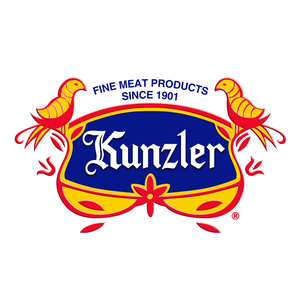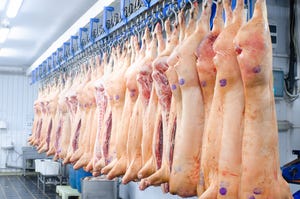’19 Pork Masters: Protecting our U.S. pork population
Veterinarian Scott Dee finds answers off the beaten path.
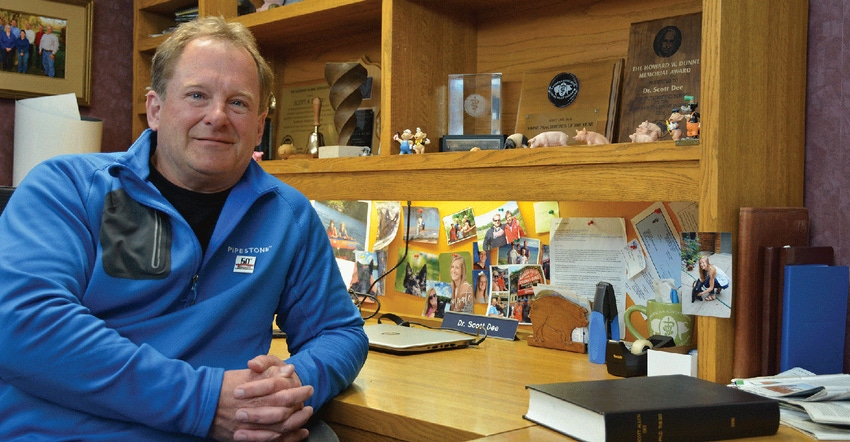
The Dutch Postimpressionist painter Vincent van Gogh once said, “I would rather die of passion than boredom.” For U.S. pork producers and the global swine industry, it’s a good thing Scott Dee also embraces that philosophy; after all, it was often boredom that led him to some of his most profound research discoveries.
“I must have a 10-year itch,” says the director of research at Pipestone Veterinary Services.
During his 32-year career in microbiology and swine veterinary medicine, it was that itch and an innate inquisitive nature that often drove Dee to take the road less traveled and find answers to some of the industry’s most perplexing challenges. We now know that subpopulations in the breeding herd can spread viruses, that air filtration can stop the spread of porcine reproductive and respiratory syndrome virus, and that viruses such as foot-and-mouth disease and African swine fever can survive in feed in a journey from halfway around the world to the heart of America.
For these contributions and many more, Dee has been chosen as one of the 2019 Masters of the Pork Industry.
Humble beginnings
From the start, Dee realized he was an outsider looking in. Growing up in Rochester, Minn., he didn’t hail from a long line of agriculturists or veterinarians. His father was a high-ranking executive at IBM in procurement who traveled the world. His mother was a schoolteacher who stayed at home once Dee and his brother and sister came along.
From an early age, Dee says he loved science and probably would have even considered being a doctor, having grown up near the Mayo Clinic, but there was one career aspiration he just couldn’t shake off.
“I knew I wanted to be a veterinarian since I was 5, but I didn’t know anything about agriculture, or anything about pigs or anything about farms. I just loved dogs, and I thought to be a doctor of dogs would be a really cool job. That was a very simple beginning, but then my dad told me that was called being a veterinarian,” Dee says. “At 5 years old, that became my goal.”
It wasn’t until he was a pre-vet student at Gustavus Adolphus College and took an internship one summer with Mayo Clinic’s research farm that he knew he wanted to move his studies from the exam table to the barns. Using animals as models for human conditions, Dee was exposed to working with populations — pigs with a hemophilia condition, goats that had a neuromuscular condition, etc.
“I had never seen interactions of animals and pathogens in a group,” Dee says. “The other thing I saw there was research, because they were using these herds and flocks to study human conditions, and they were running trials. I got to see how animals and veterinary medicine could be part of research to help people.”
He then turned his attention to veterinary school at the University of Minnesota; it just took a while to get there.
3rd time’s a charm
After three years, two previous attempts to get in and a master’s degree in microbiology, the third time was a charm for Dee. Looking back, Dee says it was a very nontraditional way of getting into veterinary medicine, but it was a route that proved most valuable.
“I did go to the university but went in a backwards route — which ended up kind of fortuitous, because I met Al Leman, Han Soo Joo, Bob Morrison, Carlos Pijoan, Tom Molitor — all of those people who became big mentors for me and got me really excited about pigs,” Dee says. “That’s how I got into pigs, because if you spent any time with Al Leman, he could talk you into studying llamas — he was so persuasive and such a recruiter — and then just the scientific aspects of that swine group.”
At one point, Dee considered becoming a swine researcher with an applied nature, since he enjoyed the field and working with the species so much, but he couldn’t give up on his childhood dream to become a veterinarian.
“I think I got to know enough people in veterinary school that knew who I was, and that I wasn’t just a number when applications came through. I also had some nice letters of reference from some of those esteemed professors,” Dee says. “I was always just missing it by a fraction of a point. It was frustrating as all heck, but good things are meant to work out.”
Learning from the best
After graduating in 1987, Dee took his first job as a swine practitioner for Swine Vet Center in Morris, Minn., working under the direction of the late Rod Johnson and Nathan Winkelman. During those formative years, Dee credits much of what he learned from meeting some of Minnesota’s most famous pork producers, such as Steve Langhorst, Kent Holden and the late Bob Christensen.
“I was spending a lot of time riding as a vet student with Tim Loula [co-founder of Swine Vet Center], and he introduced me to these legends of the industry,” Dee says. “They were very critical thinkers. They seemed to have a very scientific perspective on decision-making.”
They were also open to new ideas.
“They liked somebody that kind of came out of left field and threw them a curve on a different way of thinking,” Dee says. “They were open to that but were always ready to challenge and ask a question back.”
That was “pre-PRRS,” as Dee says, and then everything changed.
Mystery disease
When the “mystery disease” first broke in the Midwest in 1989, Dee was single at the time. During the day, he would go from farm to farm, only to discover the same story: dead pigs, dead pigs, dead pigs. Nothing could fix it. At night, he would go back to his apartment in Morris and hang his head in despair.
“Going through those first cases of mystery swine disease was probably the worst time in my life,” Dee says. “I actually got very depressed because I was so worthless as a veterinarian. Nobody knew what it was.”
Feeling “like a complete failure,” Dee knew the only thing that could save him was to go back to graduate school. From 1993 to 1996, Dee stayed in practice but returned to U-M, where he worked on his doctorate on PRRS control under the advisement of Han Soo Joo. What came out of that, Dee says, was the greatest experience of his professional life.
From the thesis came the “theory of subpopulations in the breeding herd” which demonstrated that in a PRRS virus-infected population of sows, there could be some positives and some negatives; and the positive ones could shed the virus to the negative ones.
“That was a new concept. No one had thought of a population with an unequal immune status,” Dee says. “Then, we proved the gilt was the main driver of subpopulation development, as negative animals entering a positive herd. We also did the very first studies showing that delayed entry of gilts into the breeding herd helped reduce viral spread. This led to the concept of herd closure and viral elimination.”
However, Dee says the biggest outcome of the thesis was developing the strategy of nursery depopulation: that is, taking a chronically infected nursery and emptying it, moving pigs off-site, washing and disinfecting the facility, and then weaning pigs back in. He calls it a “mini version” of today’s all in-all out system.
“We learned that the reservoir of virus to newly weaned pigs was chronically infected 8- to 10-week-old pigs. Let’s remove the source and then wean clean pigs into a clean facility,” Dee says. “It showed if you could identify where the high-risk sources of virus were postweaning, and empty the facility, you could break the cycle of infection.”
At the time Dee says it was groundbreaking research for the industry, but it also helped him personally.
“It saved me, because I was at the bottom,” Dee says.
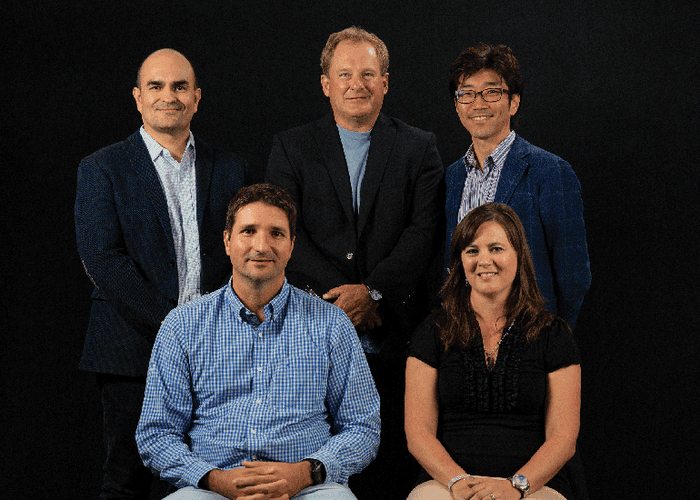
Restless and relentless
After receiving his doctorate, Dee returned to the private practice full time, but after a month or two, he was restless.
“I was getting so bored with my day-to-day,” Dee says. “I wasn’t getting any mental challenges anymore — and to be honest, PRRS virus was changing and getting more and more difficult to manage and I saw the need for more research on the transmission and biosecurity. And I knew I could only do that if I was in a 100% research-focused environment.”
He decided to take a position as associate professor at the U-M Veterinary College of Medicine and began a 12-year stint studying PRRS virus transmission and biosecurity. During that time, he and his graduate students — Satoshi Otake, Andrea Pitkin, Jean Paul Cano and Eduardo Fano — discovered viruses could spread through needles, contaminated boots and coveralls, people’s hands, insects, trucks and hair. Along the way, they developed biosecurity protocols for each of those, and they tested them before rolling them out to the real world.
“Very quickly, farm biosecurity began to improve — especially in the Midwest, but even around the world,” Dee says. “People were asking ‘How do you clean a truck, a trailer? How do you stop needle spread?’”
Next, Dee turned his attention to airborne transmission, an idea he was having a terrible time proving at the university.
One of his students, Jenny Cho, then determined that a new strain, MN-184, seemed to be traveling between farms more easily in spite of stringent biosecurity efforts in place. This set the stage for more research, leading Dee and his team to prove that all strains are not created equal when it comes to aerosol.
“We showed that certain strains like 184 spread easily by aerosol, and some older strains did not,” Dee says. “PRRS virus had adapted somehow to become more of an aerosol threat than just a simple mechanical threat.”
Filtering U.S. systems
The aerosol threat bothered Dee, and it sent him overseas to the “Iowa of France,” as he refers to the administrative region of Brittany. In this hog-dense region, the pork producers had been very successful in keeping PRRS out by using a positive-pressure HEPA (high-efficiency particulate air) filtration system.
“I knew I had to figure out a way to make this happen under negative-pressure ventilation and using a much cheaper filter,” Dee says.
Along with Pitkin and Otake, Dee set up the production region model consisting of four buildings, all close to one another. One facility contained 300 grow-finish pigs, the “source population;” and downwind from that sat three small double-L nurseries — some filtered and some not. The source population was infected with the MN-184 PRRS virus strain and Mycoplasma hyopneumoniae. Downwind were the nursery barns housing negative pigs, and every two weeks new pigs were brought into the source herd to “keep the infection active.”
Using this approach, airborne pathogens were detected in exhausted air from the source population, across the landscape and right outside the downwind facilities. However, the barn that was filtered always remained free of infection.
In addition, Dee teamed up with Steve Pohl, South Dakota State University professor of agricultural and biosystems engineering, who could calculate the correct number of cubic feet per minute and the airflow, measure the resistance, and determine how many filters and how much inlet space was needed to ensure the pigs would get enough air. Dee could manage the virus, and Pohl could handle the engineering aspect; however, they still needed some farms to test out their theories.
Cue in Gordon Spronk, co-founder of Pipestone System, who believed he had PRRS-positive farms getting infected by aerosol.
Spronk had the vision of filtering a large commercial sow farm, something that had never been done at that time. The sow farm that Spronk suggested had 3,000 sows, was in the heart of pig production in southern Minnesota and broke at least once every year with a different strain of PRRS virus. The filtration practice had worked on a small scale, both in the boar stud and the production-region model. Would it work in a real-world model?
With the team’s filtration system in place, that barn stayed PRRS-free for the first year, which it never had done before, and it is still filtered today. Of the 70-plus farms Pipestone manages today, more than 60% are now filtered.
A job, please
After the air filtration project, Dee admits he once again found himself getting bored and was looking to move on to the next challenge.
“I loved my time at the U-M, but I saw the opportunity at Pipestone to work with big systems and a very aggressive, research-minded group of veterinarians — and it just seemed like I could make a bigger impact here working on this air filtration aspect rather than at the university,” Dee says. “I was a tenured full professor and could have stayed there for life, but the itch wouldn’t stop!”
In 2011, he approached Spronk and Luke Minion, Pipestone CEO, and asked for a job. They didn’t know exactly what he was going to do, but they agreed he could continue his research in filtration and go from there.
“I was so excited to join Pipestone,” Dee says. “I had all these friends that were vets on staff, and I loved the company culture of wanting to do things based on science, based on economics, with the ultimate goal of serving the producer.”
Then came porcine epidemic diarrhea virus in 2014, and everything changed again.
“PEDV was getting into these ‘bulletproof’ farms of ours. They had air filters, they had truck washes, they had shower in-shower outs,” Dee says. “They were like Cadillacs. They had not been infected with PRRS virus for years, and then all of a sudden, we had a rash of PEDV-infected farms the first week of January 2014.”
With no other link among the farms, the Pipestone team put their heads together and determined it had to be feed.
“You couldn’t spread a disease that fast if you drove by a farm and threw it in the window,” Dee says.
To prove it, Dee, along with Pipestone team members Joel Nerem and Adam Schelkopf, identified a subset of recently infected sow farms that were completely unrelated as far as mill, transport and people. All had an index group of sows, or a little cluster of animals that had the clinical signs of PEDV, but the disease hadn’t spread through the whole site yet. Each farm’s index group of sows had been fed through the same bin, and all had experienced a feed outage at the same time.
The challenge was how to collect the best sample to represent tons of feed. Looking down into the feed bin, Dee noticed feed dust material hanging around the inside; and he thought if he could get some of that dust, it would best represent all those tons that came through that bin. With a long pole and a paint roller, Dee collected his sample and sent it off to a diagnostic lab to see if the virus was present in the bin. PEDV was there.
Since that was just polymerase chain reaction testing, he next ran a bioassay at SDSU to see if the virus was alive and could infect pigs. Sure enough, the virus in the bin was alive.
Looking back, Dee says that was a major turning point in his career at Pipestone. Feed biosecurity was uncharted territory for the veterinarian, and at the time, some of his research was met with resistance. Spronk encouraged Dee to carry on, but to make sure it didn’t look like they were “throwing stones” at the feed industry by any means. Instead, he wanted everyone to work together to protect farms.
“The feed industry has a completely different mindset with ASF than they were PED, because we are not infected,” Dee says. “Now they are trying to do everything they can to proactively share their QC [quality control] protocols. It has been very impressive.”
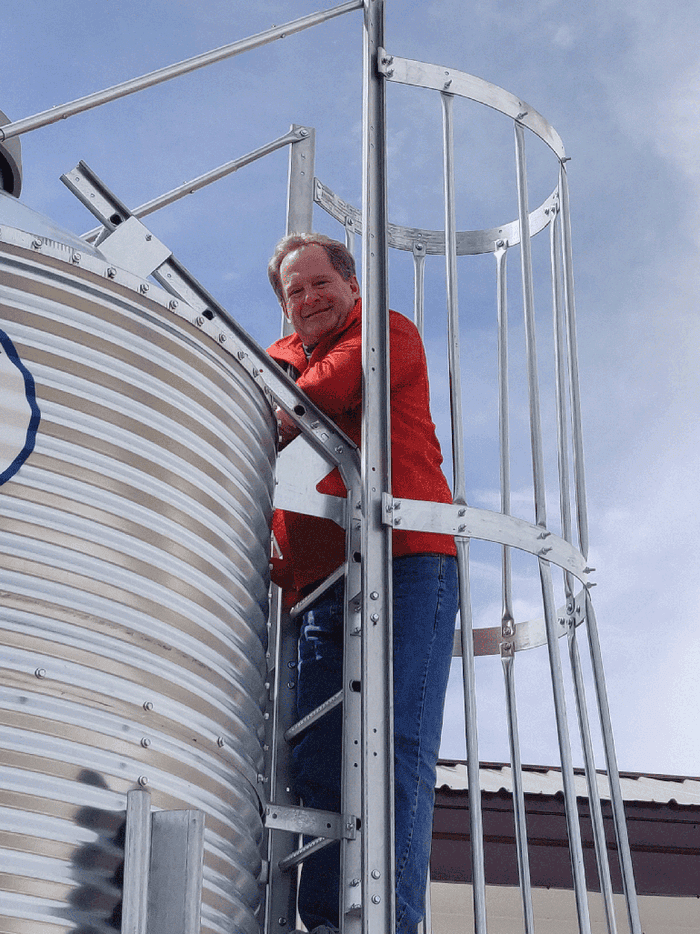
Transboundary survival
After the U.S. became infected with PEDV, the Pipestone team raised the question of whether contaminated feed could have served as a vehicle for the initial virus entry into the U.S. swine population from China, due to similarity in genetic relationship.
“At Gordon’s request, I visited his brother Randy’s feed mill and saw many bags of feed ingredients that had been sourced from China,” Dee says.
Dee came up with a novel idea to study the theory: a transpacific transportation model. By spiking feed ingredients commonly imported from China to the U.S. with PEDV, and subjecting the mixtures to environmental conditions simulating a 37-day trip from Beijing to Des Moines, Iowa, he — along with Eric Nelson and Diego Diel from SDSU — showed that PEDV survived the transport period in five key ingredients used to formulate porcine rations, including soybean meal (organic and conventional), vitamin D, lysine hydrochloride and choline chloride.
This new “CSI approach” captured the attention of Paul Sundberg, who was just starting the Swine Health Information Center. He liked the model and asked them to test 10 more viruses, one being ASF virus. SDSU and Pipestone had no way of working with that virus; however, Kansas State University had just opened its Biosecurity Research Institute, a biosafety level-3 facility, and could work with the actual ASF strain that broke out in the republic of Georgia.
“I had always appreciated the work of Megan Niederwerder from KSU, and we asked her to join the team,” Dee says.
Since ASF wasn’t in China at the time, but in Eastern Europe, Dee developed a transatlantic model starting in Warsaw, Poland, and traveling all the way to Des Moines. As they published in the journal PLOS One, seven of the 11 animal viruses tested survived the transglobal journey from either China or Europe to the United States in multiple feed ingredients.
Since the transport research, Niederwerder has published a study confirming ASF can be easily transmitted through the natural consumption of contaminated feed and liquid. Dee calls it the “ripple effect” of research and couldn’t be more pleased.
“It could be the best thing I’ve ever done. It could be the final thing I do with the greatest impact. If we can show this idea of feed risk that came out of Pipestone and turn it into this global effort with all the support of multiple universities, it will be a true ‘win-win,’” Dee says. “It’s the ripple effect. This whole thing on feed is affecting not only the swine industry but the FBI Weapons of Mass Destruction Directorate, the USDA, FDA, DHS [Department of Homeland Security], all the way up to Capitol Hill.”
With the recent decision of the Canadian Food Inspection Association to restrict imports of high-risk ingredients from ASF-infected countries and the National Pork Producers Council’s passage of resolutions at National Pork Forum to do the same in the U.S., Dee says things are changing fast.
“The risk of feed is a big huge elephant in the room that no one has ever really looked at before, and all of a sudden, we have this data set that clearly states that the virus can live in feed [transport], and pigs can become infected by eating it [transmission]; it’s a significant paradigm shift,” Dee says.
2019: Year of the mitigant
Following the positive results on virus transport and transmission, Dee put out a call to the feed industry to see if there were companies interested in testing additives. What’s come forth have mainly been organic acid mixes, medium-chain fatty acid blends and formaldehyde-based products; Dee says so far, he’s seeing promising results with the chemistries, not sterilizing the feed but reducing virus load, and either preventing infection or minimizing clinical signs of several viruses.
“That could be a great tool for us if we can adapt that, either into wide-scale application or the importing of products that we have been treating or storing,” Dee says.
He calls 2019 “the year of the mitigant” and plans to test 10 additional products this year. The 60-year-old plans to retire in the next four to five years, so he recognizes this could be his final contribution to the industry.
“Along with Gordon, I’m going to put the coals to this feed thing, and hopefully four to five years from now, our industry is still free of foreign animal diseases which are spread through feed, and it will be time to pass the torch to others” Dee says.
Looking back
If he had to do it all over again, Dee says he wouldn’t change a thing, even if he took a less traditional route. He’s been blessed with a supportive family: his wife of 26 years, Lisa; and their children, Nicholas and Ellen, currently students at Concordia College in Moorhead, Minn. Every time Dee has taken a new position in Minnesota, his family had held down the home base in Alexandria.
“Rule No. 1 for any job I’ve taken: I’m the one that moves. Everyone else stays, because that’s what they want to do,” Dee says.
While he misses his early mentors Pijoan and Leman, he’s especially enjoyed the last 10 years working with Spronk.
“He’s both a best friend and a big brother. He’s the primary reason I came to Pipestone,” Dee says. “The more time we spent together, the more we realized we think a lot alike, and we get along, and we have fun together.”
His work with PEDV in feed may have started a new chapter in veterinary medicine; however, Dee says it’s been more fulfilling to see his current feed work getting replicated by multiple universities and multiple people.
“Many groups are showing that this is a reproducible event, not just something I did by myself,” Dee says. “That is what I’m really proud of, and it gives me confidence that the results are right, because it’s a big hairy deal to try to deal with the feed system. KSU, SDSU, ISU [Iowa State University] and U-M have all made significant contributions and replicated the work.”
Future looks bright
Dee is confident the industry will be in good shape 10 years down the road, with so many bright young minds coming up in the ranks.
“We have so many bright people that are so proactive, we are going to remain free of foreign animal diseases because we are going to adapt,” Dee says. “The industry adapts so quickly. If there is good science behind it, there is usually pretty good acceptance. It’s so great to see producer leadership here in the U.S. That’s how it’s meant to be”.
His advice to those rising young stars includes tapping into the right side of the brain and having an appreciation for the fine arts. He’s often found inspiration from playing the bass and listening to Paul McCartney and the Beatles.
Finally, he suggests staying curious. “Have an inquisitive nature; ask the right questions,” Dee says. “When on-farm, look for things that don’t make sense and try to determine if there is a better way to accomplish the task!”
About the Author(s)
You May Also Like

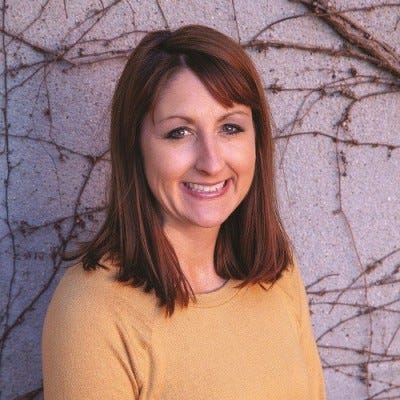
.png?width=300&auto=webp&quality=80&disable=upscale)
